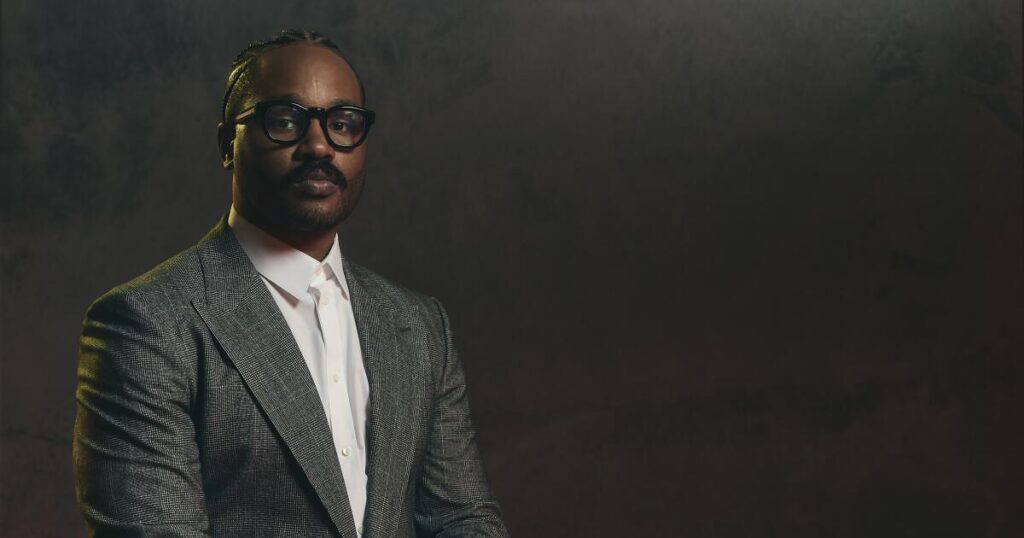Ryan Coogler was deep into writing “Sinners” when he realized the movie was missing something: He needed a moment that would jolt the audience and plunge them into a different space.
“Instead of watching the rest of the movie from here,” Coogler tells me, pointing to his head, “you take them here,” he says, patting his heart. “Like ripping you out of one movie and dropping you into another.”
As a moviegoer, Coogler is addicted to those perspective-shifting moments — Ricky getting shot in “Boyz N the Hood,” Bambi’s mom meeting her demise, the housekeeper returning in “Parasite.”
“I remember every movie that made me say, ‘Yo, what the f—,’” Coogler says. “And I was feeling like, ‘Man, I don’t know if I’ve given people that feeling enough. I haven’t taken enough of those risks when I’m making my movies.”
So Coogler wrote a scene that wound up becoming the centerpiece of “Sinners,” the critically acclaimed, genre-defying blockbuster that explores the intrinsic power of American blues music and Black life in the Jim Crow South within the context of a vampire horror movie.
If you’ve seen “Sinners,” you know the moment. Nearly an hour into the movie, the juke joint operated by twin brothers Smoke and Stack (both played by Michael B. Jordan) is up and running and young Sammie (Miles Caton) steps into the spotlight and starts singing. In a voice-over, we’re told that some musicians have the gift to make music so powerful it can summon spirits from the past and the future. And, as the screen opens in the Imax format, we see just that happening, creating a party so popping that it sets the roof on fire.
“Sinners” is a movie so audacious in design and rich in detail that you’d need a book to explore it with the depth that it demands. So in talking with Coogler and his longtime department heads, a movie family that includes Oscar winners who have been with him since his 2013 debut, “Fruitvale Station,” it felt right to focus on this one monumental sequence, the standout scene in the movie — and the standout scene in the moviegoing year.
Coogler: It wasn’t one of the fundamental scenes I was thinking about before I started writing the movie. But once I got into writing it, I was always asking myself, “Why are we with this kid in the movie?”
Michael P. Shawver, film editor: Originally the movie started with the scene of [vampire] Remmick showing up when he’s being chased by the Choctaw. It was a great idea to start with the vampires, a Wes Craven-style of scaring the s— out of the audience and then building up the story. But Sammie is the vessel for the story, so it worked better to start the movie with Sammie in the church and have those jump-scare flashes in there to give hints of things to come.
Coogler: Sammie’s the Luke Skywalker in this movie. But until he starts singing in the juke joint, you don’t know that. He’s a generational talent. So getting to that scene, I thought, we have a cool opportunity in a movie that’s got all types of supernatural s— that’s in the vampire tradition. Maybe we can take a risk and put the audience in a place that they recognize here, an awesome party and a crazy performance that stops space and time and gives you an out-of-the-body experience.
Ruth E. Carter, costume designer: Ryan’s a humble guy. He’s very much a family guy. He seems so normal. Then you read that scene in the script, and all of us kind of whispered to each other in the beginning, “Did you read that scene?”
Ludwig Göransson, composer: I was like, “Oh my God. I could never have imagined this idea.” In a big-budget, Hollywood film, you have a six-minute music montage? And everything there was on the page — the psychedelic rock guitar player, the DJ, the Memphis jookin dancers. I got goosebumps. But also thinking, “Ryan’s setting the bar really high. How do we make this real?”
Hannah Beachler, production designer: Ryan’s always going to take you on an adventure. Get ready for it. Mississippi Delta? Great. I live in New Orleans. We’re going to be recording the music live? That’s new. Vampires? That’s a twist. A juke joint? Great. His thing was like, “I want to put a fish fry on 70mm.” So you better make sure the fish is being fried correctly in the kitchen.
Coogler: Marvin Gaye’s “I Want You” was a huge inspiration for this movie. Look at that album cover. He chose a sugar shack. It’s a juke joint. And the song. It’s not enough to be needed. You want to be wanted. That was very motivating writing this. That got me in a bluesy mindset. Marvin Gaye was doing the blues. That song Sammie sings had to have that.
Miles Caton, actor: The first time I got the script, they prompted it as a 19-year-old sharecropper who’s a musician, and he would have been Sam Cooke if it was 20 years later. After I got the role, they sent me the full script. And I’m in my room by myself reading it, thinking, “This isn’t a music biopic.”
Göransson: Ryan and I talked about the song a lot. He wanted it to be timeless.
Coogler: I wanted something that could be carried by guitar and carried by voice, something that could be sung from 1932. Ludwig suggested Raphael Saadiq. We talked and he told me that he had this blues song he had been working on since he was a kid.
Göransson: Raphael came to my studio and we dialed up Ryan on the phone. Ryan told him about Preacher Boy [Sammie] and his relationship with his dad and how he’s defying him, leaving the church to follow his own dream. Raphael started writing the lyrics and it had all that, but also the element of “take me in your arms tonight.” Remmick hearing that is like a siren’s call.
Coogler: When he sang the lyrics to me, I realized something I didn’t know. The song had to be about seduction. Just like Marvin Gaye and “I Want You.”
Caton: I remember hearing it for the first time, thinking, “This is everything Sammie wants to say.” I can’t wait to get to the juke joint and sing it.
Beachler: The juke joint had to feel like a place that might go on forever, a place with so many stories of dance and joy.
Carter: The movie is a story about survival and joy as well as being a vampire story. You see people starting their day in this huge field picking cotton. These people have nothing, but they show up at the juke joint and you see the sweat and grit and grime on the clothes next to people who made a nice dress. They’re all there for a good time on a Saturday night.
Autumn Durald Arkapaw, cinematographer: Then come Sunday morning, they go to church and maybe ask for forgiveness.
Beachler: The first sketches of the juke joint I drew were red, representing capitalism, hedonism, all the things we are under the cover of the dark. You go out, you feel free to be somebody else when the lights are down low. Then as I started getting more inside the space, I realized that every character brings the most evident thing about their environment in there. Every location in the movie is inside the juke joint. Everybody has a twin.
Coogler: Once Sammie starts singing and the dancers and musicians come in, I wrote it to have representations of who the principal characters would be like in the past as well as the future. With Sammie, the first ancestor we see is playing that string instrument and his future representative is the electric guitarist. With Slim (Delroy Lindo), it goes to his future representative, the DJ, and then to the griot on the drums. That’s the pattern with everyone.
Carter: It’s a walk through how music, culture, dance is all rooted and connected together from African roots, from the African diaspora meeting the African American diaspora.
Arkapaw: I think everyone on set felt the ancestors around us.
Carter: The Zaouli dancer knocked me out. That was a real dancer from Africa who knew how to do that fast, isolated foot movement. The scene had everything — the Memphis jookin, the Maasai in the background. You see them all, sometimes in just glimpses. I’ve watched that scene a thousand times. I just love the way the camera moves and captures it all.
Arkapaw: The scene looks like a oner, but it’s three Steadicam shots, 76 seconds each, stitched together. And the reason for that is because you have to down-spool the Imax camera magazine because it’s too heavy for the operator to hold. My focus-puller had the hardest job in the world, moving from character to character.
Caton: I sang the first part of the song live. Ryan was like the coach. “This is Sammie’s big moment. I need 1,000%.” After each take, he’d ask, “What do you think the energy was?” I’d be, “That was about an eight.” He was like, “Give me an 11.”
Beachler: You can’t imagine how special it was to be on the set watching all that. When you see that futuristic Bootsy Collins figure, it drops the question, “Where can it go?” We have so many moments to go, so many ancestors to happen.
Shawver: Because we added the prologue, the animated sequence setting up the world of music and magic, the audience got what we were doing. We stated right away that there’s magic here and that life and death is blurred when music has a certain quality to it. Without that, people would be wondering, “What the f— is Bootsy Collins doing here?”
Coogler: The risk of the scene is that it could rip the audience out of the movie, but in the wrong way. When we would show the movie, the scene would always get a rise out of people. They reacted to it passionately. And we had to be comfortable with that.
Göransson: I love watching the audience when the scene starts and the screen opens up. Nobody is expecting what’s about to happen. How could they?
Shawver: There were some, not a ton, of loud voices saying they were confused or we should take out the scene. Our rule is to always elevate what’s unique about the movie. One thing all of Ryan’s movies have in common is that you feel like you went through something substantial.
Arkapaw: It’s a scene where Ryan’s asking you to go and explore with him for a moment. He’s asking you to open your mind. It was a brave shot that proves when you feed the audience something very emotional, they will respond even though it’s such a big dive.
Coogler: Every movie should have its version of that scene, if it can hold it. All the choices we made had to commit to getting to it. We had to say, “This is maybe the most important scene in the movie. Everything that came before and everything that comes after has to support that.” Seeing it come together was one of the most rewarding moments of my career.
Arkapaw: The first time I saw the movie, I’m sitting next to Ryan and when it was over we just looked at each other. It felt like we didn’t do that. You were watching something that you know you were fully a part of, but then watching it complete, you had this feeling of like, “Were we even there?” It was very emotional. It makes you very happy to make a picture that you can feel in your bones.
Coogler: There’s no better feeling than to look back and think, “That s— was crazy. But it was also amazing.”
The post An oral history of the ‘Sinners’ musical sequence: Inside the year’s best scene appeared first on Los Angeles Times.




